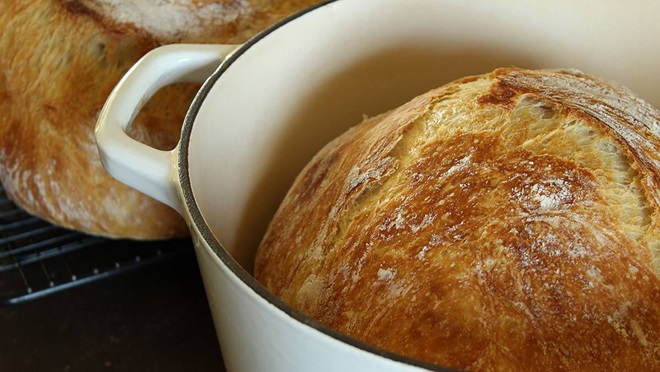Have you jumped on the bake-your-own bandwagon? If there's anything regular pandemic lockdowns have taught us, it's that taking the time to bake your own bread is not only a satisfying and pleasurable time-filler, but also often a better, tastier and healthier option than buying processed loaves from the supermarket.
So if you're running low on your sandwich stash and want to avoid a shopping trip, give this quick-knead recipe from our CHOICE kitchen experts a go. It's so simple to make and there's no breadmaker required: you can do it all in your trusty cast-iron pot (also known as Dutch oven). You just need to prepare it a day in advance.
"Dutch ovens are great conductors of heat, so if you bake bread using this method it will cook very evenly," says CHOICE's kitchen expert Fiona Mair.
"Baking with the lid on for the first stage traps steam inside the Dutch oven, which is what you need to get that initial rise. It also gives a nice shape and structure to your finished loaf."

How your dough should look after step one. If yours looks a little dry, add some extra water, one tablespoon at a time.
Recipe for quick-knead bread
Ingredients
- 4 cups plain flour
- 1 tsp dried yeast
- 1 tsp sugar
- 1 tsp salt
- 450ml warm water
- 1 tbsp white vinegar
Method
- In a large bowl, combine all the ingredients using a wooden spoon until the mixture resembles a stodgy, sticky dough.
- Cover and let the dough stand overnight, or for approximately 8 hours. You may like to prepare the dough in the afternoon and leave overnight so it's ready to bake in the morning. After resting, your dough will be bubbly and sticky.
- Place dough onto a well-floured surface and knead for 4 minutes, adding flour as needed, until smooth and elastic.
- Shape your dough by folding the edges into the centre, then turning it upside down and tucking in the sides to form a ball.
- Line base and sides of a 4L or 5L Dutch oven with greaseproof paper and gently place the dough in the centre.

Line your Dutch oven with greaseproof paper and gently place the dough inside.
- Spray the top of the dough with oil and cover with plastic wrap and a tea towel. Set aside in a warm place to prove for a further 2 hours.
- Meanwhile, preheat oven to 250°C (fan-forced).
- Using a razor blade or sharp knife, make a 1cm-deep slit down the centre of the dough and sprinkle with flour.
- Place the lid on the Dutch oven and place on the second shelf (from the bottom) in your oven.
- Bake for 20 mins then remove the lid and bake for a further 20-25 minutes. You'll know the bread is ready if it sounds hollow when you tap the top.
- Carefully remove the bread from the Dutch oven and place on a wire rack to cool.
- Slice, serve and enjoy!
We're on your side
For more than 60 years, we've been making a difference for Australian consumers. In that time, we've never taken ads or sponsorship.
Instead we're funded by members who value expert reviews and independent product testing.
With no self-interest behind our advice, you don't just buy smarter, you get the answers that you need.
You know without hesitation what's safe for you and your family. And our recent sunscreens test showed just how important it is to keep business claims in check.
So you'll never be alone when something goes wrong or a business treats you unfairly.
Learn more about CHOICE membership today
Stock images: Getty, unless otherwise stated.




